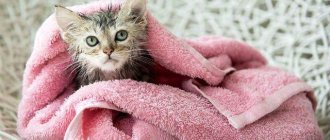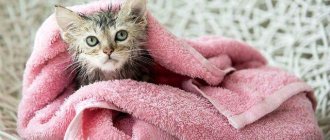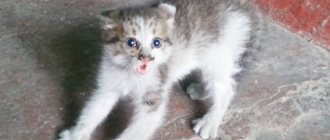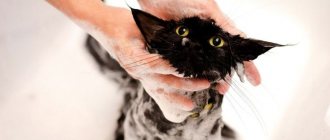Most cats avoid water treatments. However, this is one of the important components of hygiene. How correctly a kitten is bathed for the first time determines its attitude towards water for many years. Therefore, it is necessary to approach this event responsibly: choose a suitable detergent, study the advice of felinologists and, of course, be patient.
The advisability of bathing
Cats are very clean animals. They devote several hours every day to thorough licking. With the help of a rough tongue, pets are able to remove almost any dirt, as well as lost hair and skin flakes.
This desire for cleanliness has practical implications. Cats try to neutralize their own scent in order to sneak up on their prey unnoticed during the hunt.
Fear of water can also be explained. A wet pet quickly becomes hypothermic because it loses its ability to thermoregulate. Domestic cats living in “greenhouse” conditions have a rather weak immune system, which is not always able to withstand adverse factors.
If you bathe a kitten with an aggressive shampoo, the protective lubricant will disappear. Because of this, the fur becomes dry and brittle, and the skin begins to peel. Therefore, only special cosmetics are used for washing.
The kitten needs to be bathed when the following signs appear:
- the wool smells unpleasant;
- skin becomes sticky;
- abundant fatty deposits appear;
- the kitten has fleas;
- Dirt accumulates in the folds of the skin.
Cats are bathed if they are very dirty. For example, in any chemicals, soot, oil. In this case, licking the fur will cause serious harm to the health of the pet.
Consequences of non-compliance with temperature indicators
- Hypothermia. Using cold water increases the risk of developing colds. For kitten owners, this is an additional risk of hypothermia (a decrease in body temperature lower than necessary for its normal functioning and metabolism).
- Overheat. A cat's skin is much more sensitive than a human's. Therefore, in hot water the animal runs the risk of overheating or even being burned.
- Dry skin. Cats have their own protective layer on their fur, so if the owner starts washing the animal more often than necessary, he will have another problem - dry skin. You will notice your pet frequently licking itself, scratching itself, or showing other signs of irritation (redness, flaking). To solve the problem, seek help from a veterinarian.
Contraindications to bath procedures
There are situations when it is absolutely forbidden to bathe kittens. These include:
- Illness - avoid water procedures until complete recovery.
- Vaccination – bathing kittens is prohibited for 14 days after vaccination.
- Ringworm - along with water, the infection will spread to other parts of the body.
- Surgery – After surgery, cats are not bathed until the stitches have healed.
- Severe stress - water procedures will only aggravate the condition.
Breed characteristics
Cats with fur tolerate water procedures comfortably if the water is heated to their body temperature. That is, you can focus on the optimal +38°C.
Sphynx cats have almost no fur, so the animals quickly become hypothermic and even freeze. For these cats, the required temperature is considered to be +39…+40°C.
In any case, it is necessary to monitor the air temperature in the room. For any breed, this indicator should not fall below 23°C.
How to bathe a Sphynx cat
At what age can you bathe a kitten?
Kittens are more vulnerable than adult animals. Their immunity is still developing, so you shouldn’t risk bathing your pet too early. During washing, the temperature regime is disrupted and the fatty film that protects the baby from pathogenic bacteria is washed off.
There is no need to bathe kittens for the first 2 months after birth. The mother takes care of their hygiene. However, many breeders wash kittens as early as 1 month. This is due to the fact that they prepare animals for sale and try to provide the kids with the most attractive appearance.
In case of severe contamination, you can carefully wash a one-month-old kitten, but only if it is accustomed to its owners and has become comfortable in the apartment. If possible, it is better to limit wiping with a damp cloth.
At 3 months, when the kitten is stronger, you can start bathing it without harm to its health. There is no need to postpone the procedure. The sooner the baby gets acquainted with water, the sooner he will get used to it.
As for at what age you can bathe a kitten with flea shampoo, it largely depends on its brand. Typically, such drugs are not used for up to two months.
However, some mild flea shampoos can be used a little earlier. It is better to consult a veterinarian first and carefully study the instructions.
Washing process
How long to wash a cat depends on the animal’s preparedness, loyalty to water, and the degree of contamination of the pet. You should only use special shampoos for cats, which are sold in veterinary pharmacies and pet stores.
- The cat must be carefully placed in a bathtub that is one-third full, with an anti-slip mat at the bottom.
- Add a little water and start a conversation with the animal.
- Then pour a little shampoo into your palm, rub it and apply it to the cat’s fur. It is better to carry out the procedure together.
- Foam should not be applied to the ears, eyes, or nasolabial area of the pet’s face.
- After massaging and thoroughly washing the paws, you should rinse off the shampoo and rinse the cat’s fur with previously prepared warm, clean water, or open a tap with running water.
If a cat is fundamentally afraid of water, it is recommended to use dry shampoo to keep its fur clean. Its composition is safe for animal skin and cleanses well of impurities.
Upon completion of the dry shampoo treatment, the cat's fur must be thoroughly combed. The dirt will come off with the excess powder.
How often to wash
Cats' natural love for cleanliness makes bathing an auxiliary, rather than a primary hygiene procedure. On the contrary, too frequent washing degrades the quality of the fur.
The frequency of washing kittens depends on the breed, coat length, and health status. As a rule, cats are bathed 6 times a year. If the animal does not leave the apartment, bath days are held once a quarter or six months.
Often you can only wash kittens of hairless breeds. They get dirty faster, so they get water treatments about once a month. Show cats are given unscheduled baths before shows.
For your information. If a cat goes outside, be sure to wash its paws after each walk.
Relationship between body and water temperature
We all love to swim in pleasant water. Its degree is determined by the temperature regime of our body. The standard cat temperature is 2 degrees higher than that of a human, which leads us to the conclusion that the liquid for them should be heated more strongly. Depending on the breed, age, and personal comfort of the cat, the range of recommended limits is +36°C…+40°C.
In addition to water, the pet wants to feel comfortable in the room itself. A wet kitten can easily catch a cold in a cold or drafty room. Monitor the air temperature in the bathroom and the room where you take your pet after bathing; it should be 23°C and above.
What does a cat look like after water treatments?
How to wash a kitten
Kittens are bathed using gentle products. Shampoos are not suitable for people - they are too aggressive.
Manufacturers produce cosmetics for a specific skin type:
- dry;
- fat;
- normal;
- damaged.
The most common are liquid shampoos and conditioners. They can contain both regular cleaning agents and special components. For example, to kill fleas, ticks and other parasites.
There are other types of cat shampoos:
- Dry shampoo is in powder form. Contains absorbent components: they remove excess sebum and dead skin flakes. However, it is not able to cope with heavy pollution. Used as an express remedy for show pets or kittens that are afraid of water. Suitable for use in winter as it avoids hypothermia.
- Spray shampoo - works almost the same as dry shampoo. Moisturizes and conditions the coat, helps get rid of tangles. A good option for partial bathing, when you just need to refresh your coat.
Some owners use a mixture of baby powder, cornstarch or baking soda as dry shampoo. However, this is quite risky. By absorbing moisture, starch releases gluten. If water gets on the skin, it will swell and stick to the fur.
It will most likely not be possible to comb it out - the animal will still have to be washed. The soda must be carefully removed, otherwise the cat will be poisoned by eating it while licking it.
Important. It is better to bathe animals using industrial dry shampoos. For example, brands Trixie Trocken and Mr. Gee.
When choosing a detergent, you need to take the following points into account:
- Short-haired, long-haired and hairless kittens are bathed with shampoos from separate lines.
- You should buy shampoos designed specifically for cats, or at least for cats and dogs. However, some show cosmetics are only made for dogs. It is used in extreme cases.
- Concentrated shampoos are more expensive, but are more economical. Before use, they must be diluted with water according to the instructions.
The most popular cosmetics that can be used to bathe a kitten are presented in the table.
| Effect | Name |
| Against parasites | “Disinfectant” (Bioflor company); |
| "Lugovoy" (Agrovetzaschita); | |
| “Tar” (Clandestine); | |
| "Doctor ZOO" | |
| Medicinal | "Doctor" (Goodman); |
| "BioVax for kittens"; | |
| Beaphar Shampoo Anti Dandruff | |
| For damaged skin and coat | Iv San Bernard Zeolithe |
| Strengthening and restructuring the coat | YuuP! Professional Restructuring & Strengthening; |
| Tropiclean Lime/Coconut | |
| To regulate shedding and against tangles | FURminator spray; |
| Perfect Coat Shed Control & Hairball (8 in 1); | |
| Phytoelite (Veda) | |
| Caregiver | Iv San Bernard Atami (antistatic); |
| “Gentle”, “Marine” (Agrovetzaschita); | |
| “Velvet” (CrystalLine); | |
| Artero 4Cats | |
| To add volume | Anju Beaute Texture Volume |
Important. The kitten may be hypersensitive to some component of the detergent. Therefore, after bathing you need to monitor the baby’s condition. If an allergy occurs, you should contact your veterinarian.
How to properly bathe a kitten for the first time
If you bathe a small kitten correctly for the first time, he will not develop negative associations with this procedure. Therefore, it is so important that washing is as comfortable as possible.
Felinologists recommend adhering to the following rules:
- Do not bathe your cat after eating. Only a light snack is acceptable, but it is better to wash your pet on an empty stomach.
- It is advisable that the kitten bathe during the molting period. Washing will make the process easier, and the animal will not accumulate a lot of hair in its stomach.
- Before bathing your pet, carefully comb the fur coat and untangle the tangles. To prevent the kitten from scratching, it is advisable to shorten the claws.
- The bathroom should be protected from drafts.
- To wash your kitten for the first time, it is better to use unscented shampoo.
- At first, it is better to bathe the kitten with an assistant. One person will hold the baby, the other will perform the necessary manipulations.
- The water should not be too cold or hot. Optimum temperature +38…+40°C.
- The ears are plugged with cotton to prevent water from getting into them. If this happens, inflammation may develop.
- It is better to wet your head not with a stream of water, but with a damp sponge.
It is recommended to wash the kitten for the first time not in the bath itself, but in a small basin. This will make it easier to hold him, and the pet will feel more confident. To prevent the paws from slipping, place a rubber mat on the bottom of the container.
For your information. It is not advisable to bathe a kitten in a sink. He can escape, fall from a great height and get injured.
All necessary equipment - detergent, towels, treats, etc. - should be at hand. If your pet scratches a lot, you should take care of rubber gloves. They will protect your hands from sharp claws.
When all preparations are completed, the kitten is gradually immersed in water approximately up to the shoulders. You can allow him to hold on to the edge of the basin and at the same time pour water on him. To bathe your pet without scaring it, talk to the baby in a gentle voice during the process. A friendly intonation makes it clear that there is no threat.
Shampoo is diluted in a separate container in the required concentration and applied to the kitten’s body. The soap solution is carefully distributed with massaging movements, being careful not to wet your head. Particular attention is paid to:
- armpits;
- stomach;
- areas around the genitals;
- paws;
- places behind the ears.
More dirt accumulates here. If your pet is bathed with an antiparasitic agent, the neck is treated first to prevent fleas from escaping to the head.
Leave the shampoo on the fur for the time specified in the instructions, and then rinse the kitten with plenty of water. It is better to water the baby from a mug or wet the fur with the palm of your hand than to use a tap or shower - a powerful stream will scare the pet.
At the end, the fluffy is generously praised and treated to his favorite treat to reinforce positive associations.
Why is it important to adhere to standards?
Cats are thermophilic. Therefore, it is so important that the water does not seem cold to them. This will be a danger to the cat's health and immunity. If your cat is shivering and tries to run away from the water, it is better to try increasing the temperature a little. It is also important that the liquid is not scalding. This will scare your pet or, worse, leave a burn on the body.
Remember! For pets, choosing the proper degree of water means confidence in preventing negative emotions from the procedure and the absence of infectious contamination after.
How to wash representatives of different breeds
Representatives of different breeds require a special approach to bathing:
- Shorthaired Scots and Britons who devote a lot of time to grooming can be bathed once every six months.
- Long-haired cats, such as Persian or Siberian cats, need to be washed every 2 months.
- White kittens are bathed with whitening shampoos.
- Detergents for long-haired breeds are not used for short-haired kittens with abundant undercoat.
- It is not advisable to bathe kittens of white and blue colors, particolors and silver pets with herbal shampoos.
- To wash Sphynxes and other hairless cats, specialized shampoos are used that care for the skin. The head is wiped with sanitary napkins.
- Products for adding volume are not suitable for animals with tight-fitting hair without undercoat (Siamese, Oriental, Abyssinian cats, etc.).
How to teach a kitten to bathe
Bathing is a serious stress for your pet. To avoid health problems and not to injure the baby’s psyche, he needs to be prepared before the first wash.
Important. Kittens subtly sense people's moods. If the owner is nervous, the anxiety will be transmitted to the pet. Therefore, before swimming you need to calm down and relax.
First, the kitten is placed in a dry bath and they try to play with it. He needs to understand that it is safe here. When the baby gets comfortable, open the tap. Some pets themselves show interest and begin to play around with a thin stream of water.
The process is repeated several times until the kitten becomes absolutely calm about the procedure. Cats that cannot get used to water can be bathed in mesh bags. They restrict the movement of animals, but do not prevent water and detergents from entering the body.
Useful tips for beginners
An unprepared animal, terrified of water and spontaneously falling into a bathtub filled with water, may begin to struggle, scream, and is also capable of tightly clinging to the owner’s hands or scratching the face. These are very unpleasant and even dangerous injuries.
A cat or cat can harm itself. If they struggle vigorously, they can twist their paws and damage other parts of the body. Therefore, you need to prepare your pet for the bathing process in advance. Felinologists advise training an animal from childhood, especially for breeds with light hair.
How to dry
After bathing, the pet is dried with a terry towel and wrapped in a soft cloth. You should not rub the fur vigorously - it will become very tangled.
Then the kitten is released. He begins to actively lick himself and dries his coat on his own. The rough tongue combs the hairs and evenly distributes protective lubricant over them.
If your baby trembles for more than 5 minutes after bathing, you should use a hairdryer. The same applies to long-haired breeds. However, the baby must first be introduced to this device, otherwise he will be scared. The air flow should be warm, but not hot. During the drying process, the fur is combed in the direction of hair growth.
Important. For 12 hours, the kitten should be in a warm room without drafts and not go outside.
If you bathe a kitten correctly, it will not be afraid of water. It is important to teach your baby hygiene from childhood and use suitable detergents - then the procedure will not cause much trouble.











